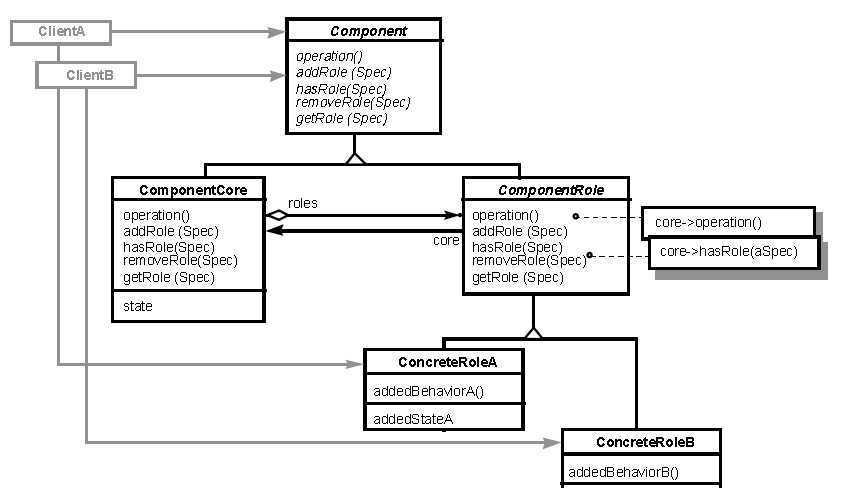标签:des style blog class code java
索引
通过明确地附加角色对象到目标对象中,以使对象可以适配不同的客户需求。每个角色对象都代表着目标对象在客户上下文中的一种角色。每种上下文都存在于特定的应用程序中,因此可使对象在不同的应用程序间解耦。
Adapt an object to different client’s needs through transparently attached role objects, each one representing a role the object has to play in that client’s context. Each context may be its own application, which therefore gets decoupled from the other applications.

Component
ComponentCore
ComponentRole
ConcreteRole
Client
当以下情况成立时可以使用 Role Object 模式:
1 namespace RoleObjectPattern.Implementation1 2 { 3 public abstract class Customer 4 { 5 public abstract CustomerRole GetRole(string spec); 6 public abstract void AddRole(string spec); 7 public abstract void RemoveRole(string spec); 8 public abstract bool HasRole(string spec); 9 public abstract void SomeCommonOperation1(); 10 } 11 12 public class CustomerCore : Customer 13 { 14 private Dictionary<string, CustomerRole> _roles 15 = new Dictionary<string, CustomerRole>(); 16 private CustomerRoleFactory _roleFactory; 17 18 public CustomerCore(CustomerRoleFactory roleFactory) 19 { 20 _roleFactory = roleFactory; 21 } 22 23 public override CustomerRole GetRole(string spec) 24 { 25 if (_roles.ContainsKey(spec)) 26 return _roles[spec]; 27 else 28 return null; 29 } 30 31 public override void AddRole(string spec) 32 { 33 CustomerRole role = GetRole(spec); 34 if (role == null) 35 { 36 role = _roleFactory.CreateRole(spec, this); 37 if (role != null) 38 { 39 _roles.Add(spec, role); 40 } 41 } 42 } 43 44 public override void RemoveRole(string spec) 45 { 46 _roles.Remove(spec); 47 } 48 49 public override bool HasRole(string spec) 50 { 51 return _roles.ContainsKey(spec); 52 } 53 54 public override void SomeCommonOperation1() 55 { 56 // do some business logic 57 } 58 } 59 60 public class CustomerRole : Customer 61 { 62 private CustomerCore _decoratedCore; 63 64 public CustomerRole(CustomerCore core) 65 { 66 _decoratedCore = core; 67 } 68 69 public override CustomerRole GetRole(string spec) 70 { 71 return _decoratedCore.GetRole(spec); 72 } 73 74 public override void AddRole(string spec) 75 { 76 _decoratedCore.AddRole(spec); 77 } 78 79 public override void RemoveRole(string spec) 80 { 81 _decoratedCore.RemoveRole(spec); 82 } 83 84 public override bool HasRole(string spec) 85 { 86 return _decoratedCore.HasRole(spec); 87 } 88 89 public override void SomeCommonOperation1() 90 { 91 _decoratedCore.SomeCommonOperation1(); 92 } 93 } 94 95 public class Borrower : CustomerRole 96 { 97 public Borrower(CustomerCore core) 98 : base(core) 99 { 100 } 101 102 public void SomeOperationForBorrower() 103 { 104 // do something for borrower 105 } 106 } 107 108 public class Investor : CustomerRole 109 { 110 public Investor(CustomerCore core) 111 : base(core) 112 { 113 } 114 115 public void SomeOperationForInvestor() 116 { 117 // do something for investor 118 } 119 } 120 121 public class CustomerRoleFactory 122 { 123 public CustomerRole CreateRole(string spec, CustomerCore core) 124 { 125 CustomerRole newRole = null; 126 127 if (spec == "Borrower") 128 { 129 newRole = new Borrower(core); 130 } 131 else if (spec == "Investor") 132 { 133 newRole = new Investor(core); 134 } 135 136 return newRole; 137 } 138 } 139 140 public class Client 141 { 142 public void TestCase1() 143 { 144 Customer customer = new CustomerCore(new CustomerRoleFactory()); 145 customer.AddRole("Borrower"); 146 customer.AddRole("Investor"); 147 148 CustomerRole customerRole1 = customer.GetRole("Borrower"); 149 Borrower borrower = (Borrower)customerRole1; 150 borrower.SomeCommonOperation1(); 151 borrower.SomeOperationForBorrower(); 152 153 CustomerRole customerRole2 = customer.GetRole("Investor"); 154 Investor investor = (Investor)customerRole2; 155 investor.SomeCommonOperation1(); 156 investor.SomeOperationForInvestor(); 157 } 158 } 159 }
《设计模式之美》为 Dennis Gao 发布于博客园的系列文章,任何未经作者本人同意的人为或爬虫转载均为耍流氓。
设计模式之美:Role Object(角色对象),布布扣,bubuko.com
标签:des style blog class code java
原文地址:http://www.cnblogs.com/gaochundong/p/design_pattern_role_object.html